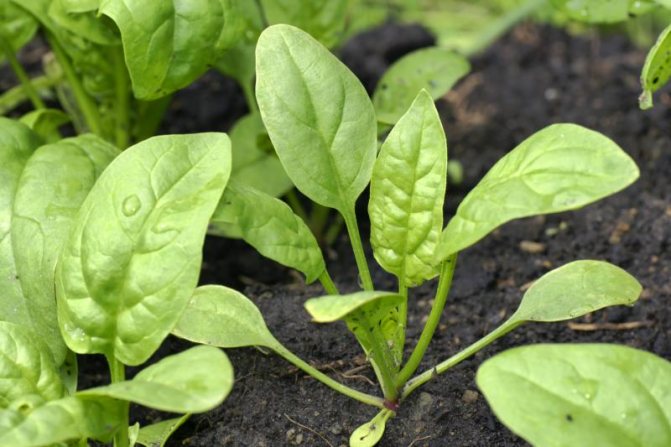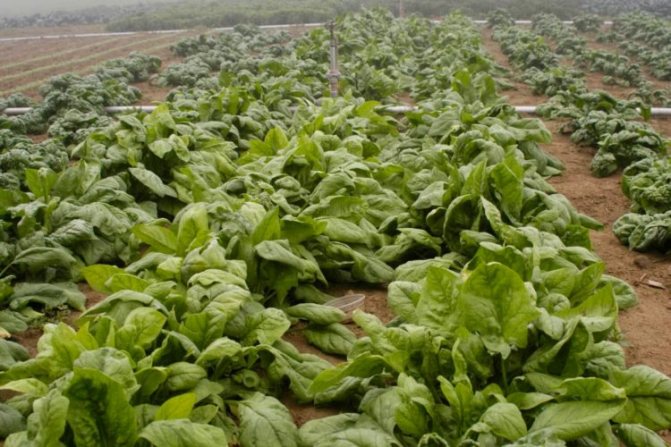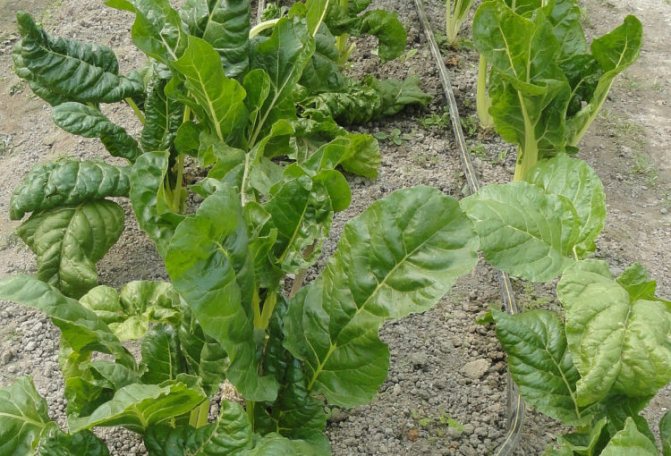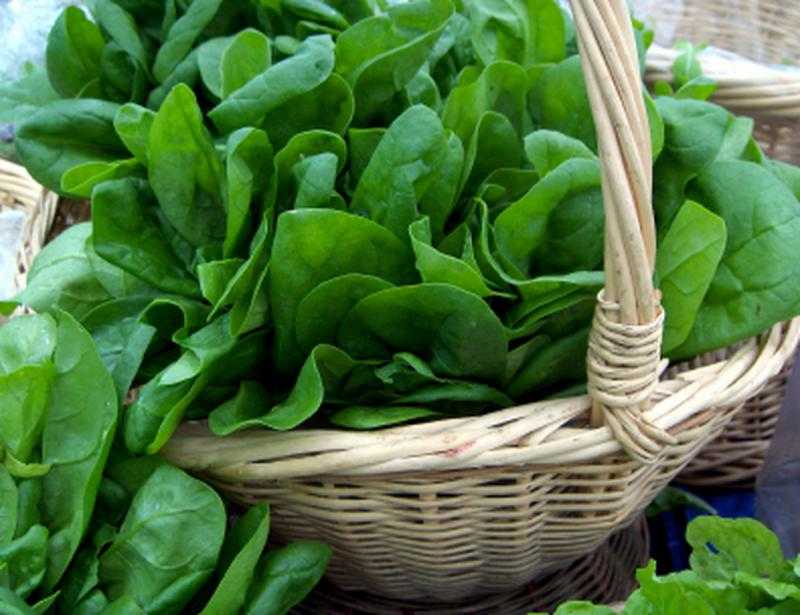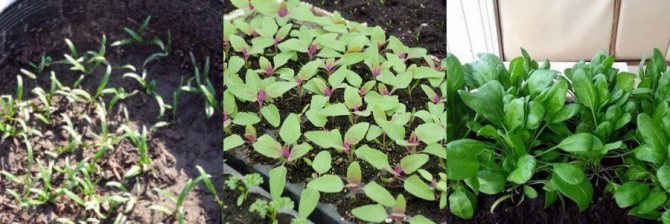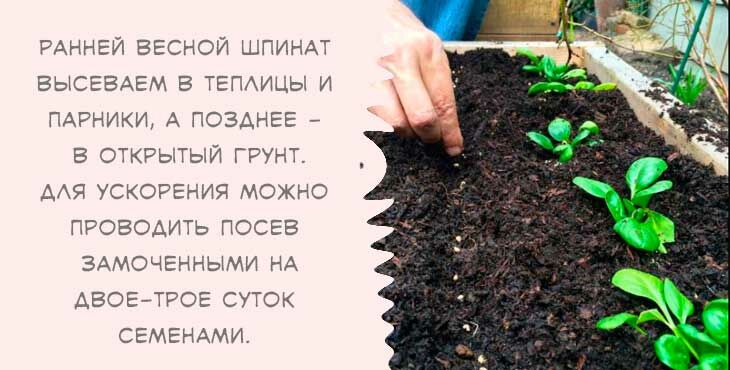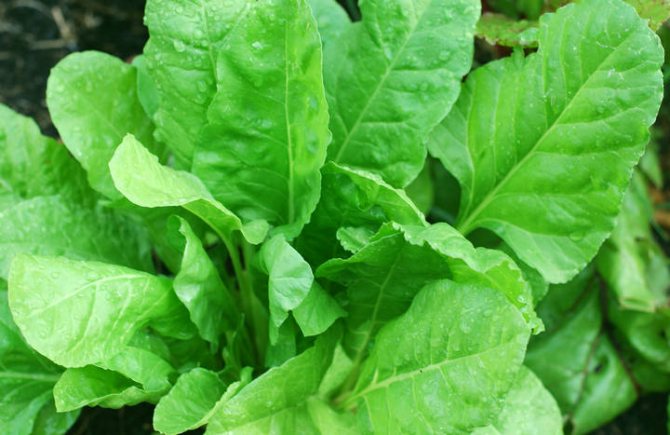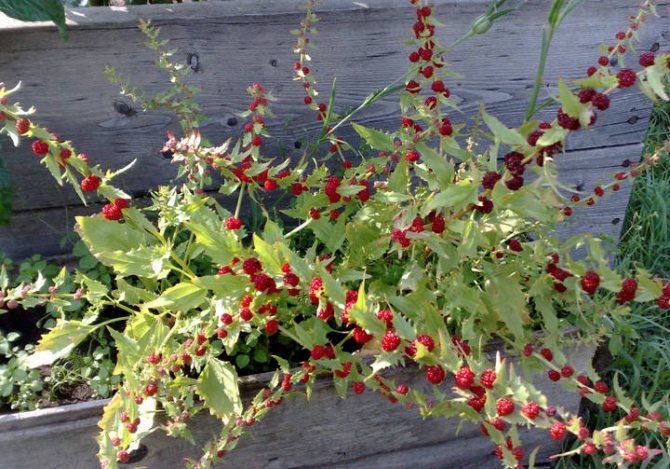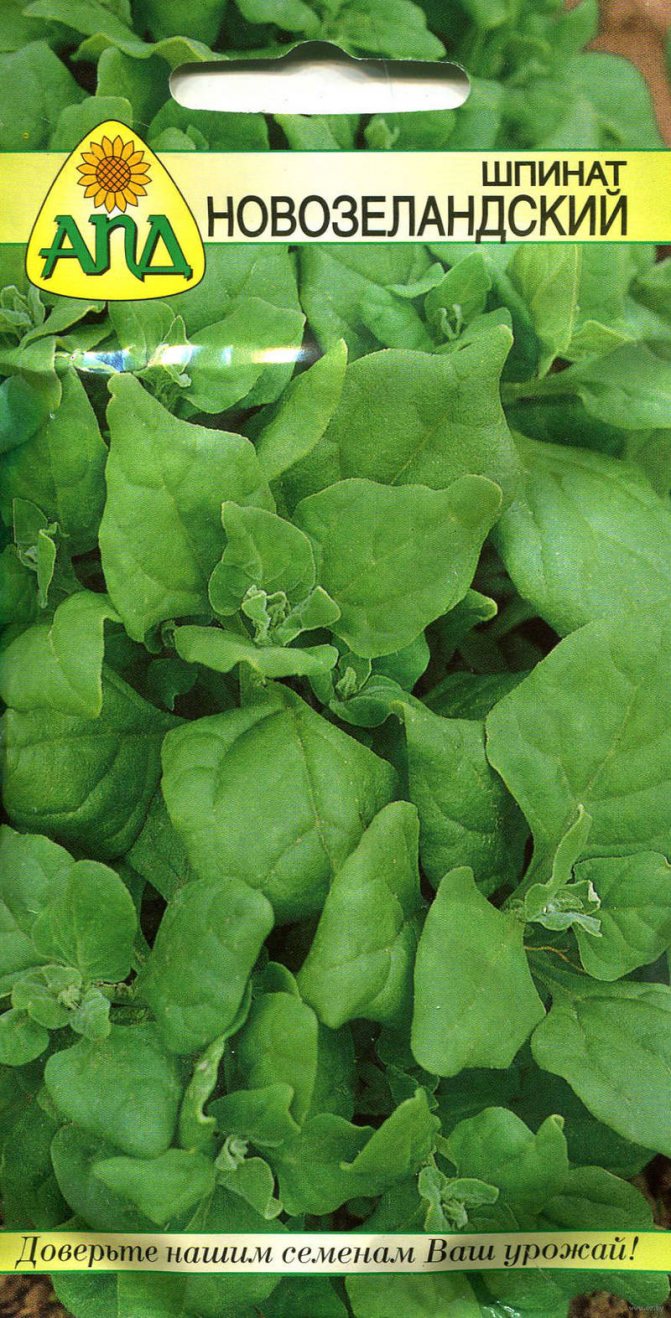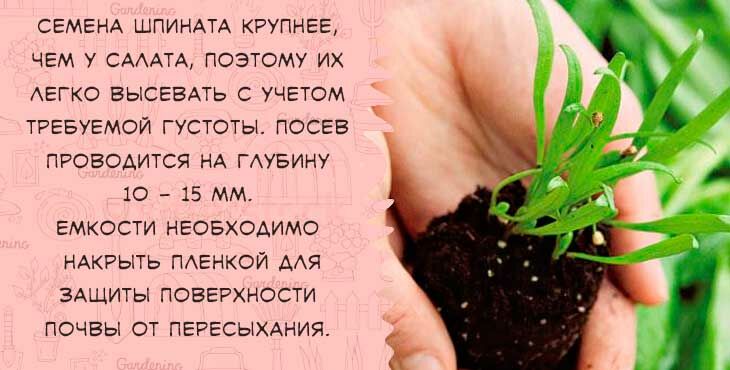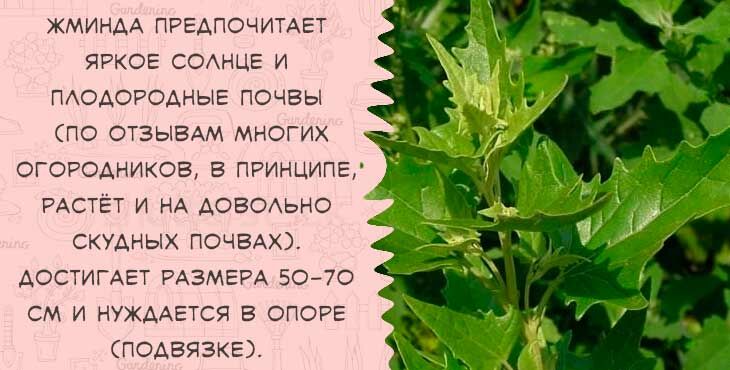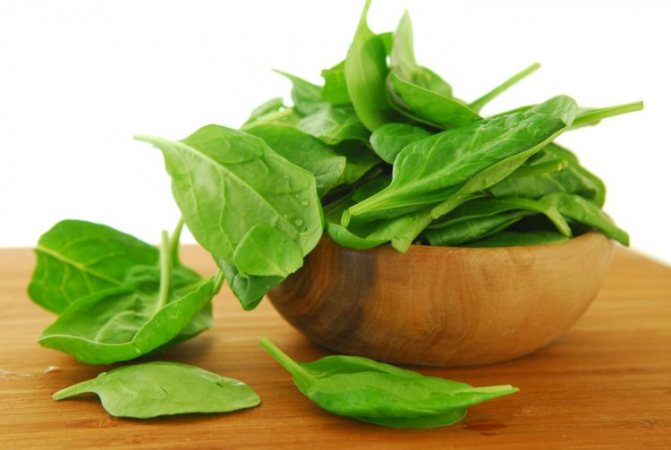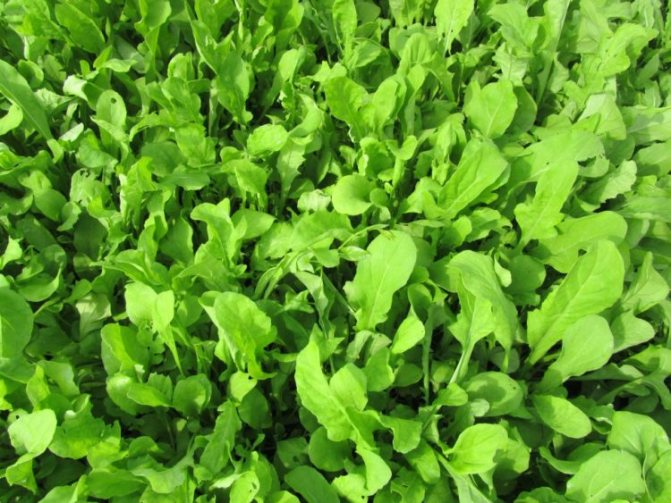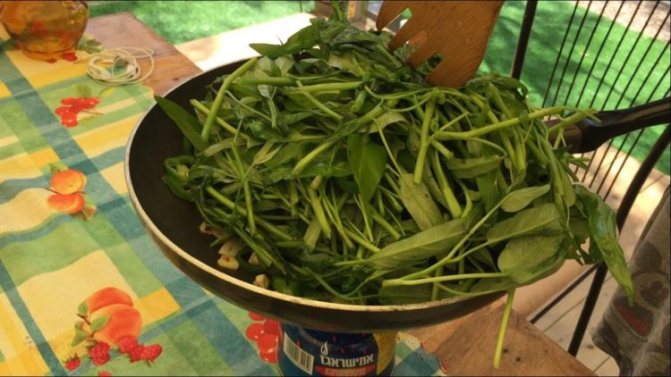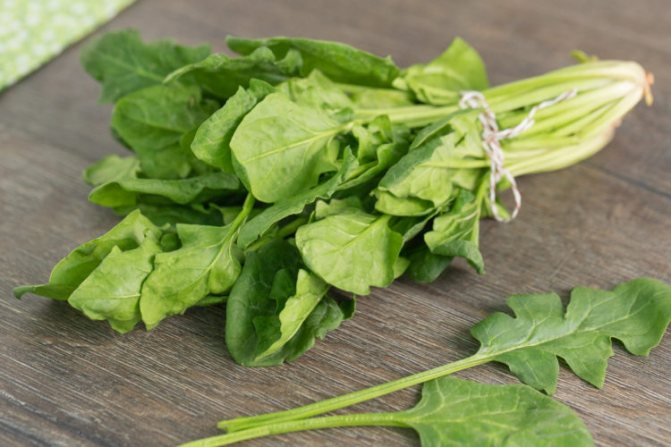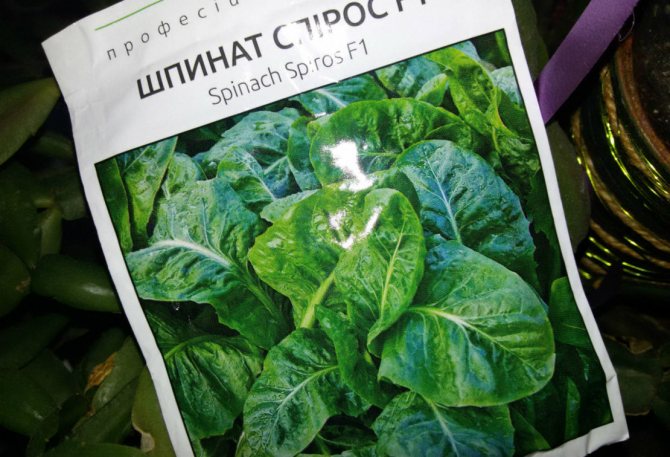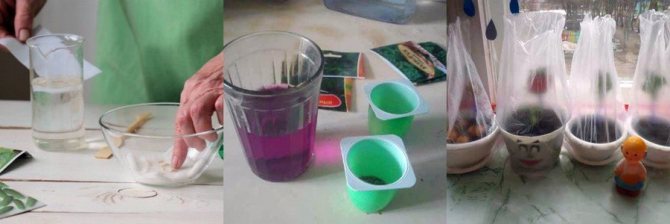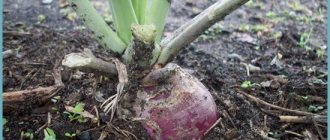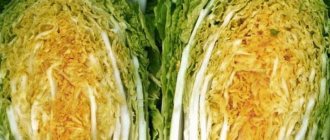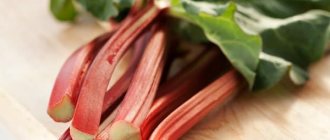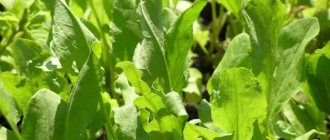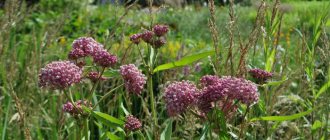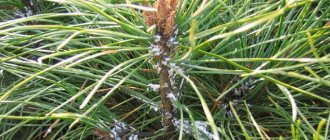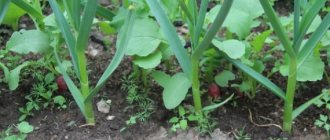Features and conditions for growing spinach
Spinach is the king of French cuisine and an American favorite. In Russia, it is grown less often, underestimating the beneficial qualities of this leafy vegetable. The agrotechnics for growing and caring for spinach are different from other green crops for outdoor use. It overgrows very quickly and becomes unfit for food. It is a cold-resistant crop that quickly turns into flowering with long daylight hours. Improper maintenance, growing in arid climates and very dense seeding will also speed up shooting.
Advice! Spinach has a small root system, so it can be sown in a home greenhouse, open loggia, or on a windowsill. It grows quickly and can be harvested several times per season.
The plant needs care until it starts growing. Young shoots require care - they are regularly watered, removed weeds, and loosened the soil. Agricultural technology for growing crops in the open field:
- Grown up spinach is surprisingly unpretentious in care, it can not stand only stagnant water at the roots and strong drying out of the soil. It develops rapidly, early ripening varieties are edible as early as 2 weeks after germination.
- If the weather is dry, caring for spinach necessarily includes watering, then the open damp ground is mulched with sawdust.
- The plant does not need fertilizers during growth in the garden; it is better to underfeed it than overfeed it. The leaves easily accumulate nitrates from excess nitrogen in the soil.
In growing spinach from seeds, pre-sowing preparation of the land plays an important role. Caring for the site includes digging, adding nutrient and loosening components.
Landing
There are two ways to grow spinach: from seed to seedlings. The nuances of planting them in open ground will be discussed in this section.
Seed preparation
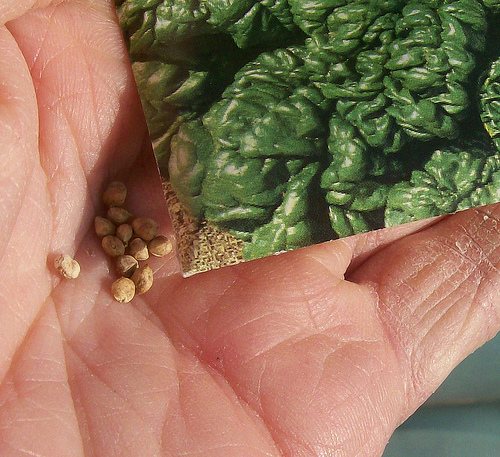
Since spinach seeds are covered with a very thick and hard shell, poorly permeable to moisture and impedes their germination, they need pre-sowing preparation, including the following:
- Calibration. During this procedure, the seeds are sorted out, rejecting damaged and defective seeds. Quality seeds are sorted by size.
- Soaking. Having wrapped the seeds with a piece of cotton cloth, put them on the bottom of a plate and pour a small amount of warm (no more than 25 degrees) water so that it covers the fabric only slightly. A plate with planting material for a day is placed in a darkened warm place, not forgetting to periodically change the water and strictly ensuring that the seeds always remain moist. After 24 hours, the seeds are removed from the water and dried a little.
- Disinfection. The planting material is kept in a bright pink solution of potassium permanganate prepared from 1 g of powder and 0.2 l of water for ten minutes. Having drained the disinfectant solution, the seeds are washed with clean water and dried, returning them to their previous flowability, after which they are sown in open ground.
Step-by-step instruction
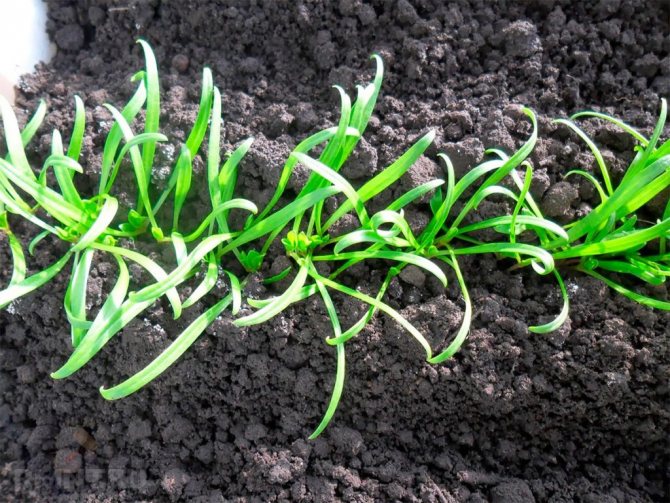

It is most convenient to grow spinach in beds fenced with boards or improvised material.
How to grow:
- Having carefully loosened and leveled the surface of the ridges with a rake, they begin to perform parallel rows (it is most convenient to do them with a wooden plank or a garden scoop).
- For planting spinach, the optimal scheme is considered, according to which the distance between rows is 15-20 cm, and between neighboring plants - 7-10 cm. With such a seeding density for each square. meter planting will require 4-5 g of seed.
- The seeding depth depends on the quality of the soil: in clay soils it should be less, in sandy soils - more. On average, it should be at least 2 cm.
- The prepared rows are carefully spilled with lukewarm water and proceed to spreading the seeds, trying to maintain a 5-7 cm interval between them. Only in this case, the plants will not stretch, and the leaf rosettes will turn out to be quite dense.
- In order to increase the contact of the planting material with the soil, the seeds are lightly pressed to the ground.
- Armed with a rake, the spinach crops are carefully covered and the soil is slightly compacted.
- You can prevent the appearance of weeds and significantly reduce the evaporation of moisture from the surface of the beds by mulching them. Chopped straw, hay or dry leaves can be used as a mulching material.
- In the presence of favorable weather conditions, the appearance of the first shoots should be expected in 10-14 days. Some gardeners speed up their appearance by covering the bed with plastic wrap.
Planting seedlings
In the middle lane, spinach is most often grown in seedlings. Depending on which container was used for growing seedlings, there are two options for transplanting it into open ground.
This option is intended for seedlings grown in peat tablets or cups:
- On the prepared beds, planting holes are made, the size of which corresponds to the dimensions of peat containers with seedlings, not forgetting to observe the recommended spacing between plants.
- The pot with the plant is carefully placed in the planting hole and a little sprinkled with earth.
- The planted seedlings are watered at the root.
The next technique involves the need to transplant seedlings that can be grown in boxes or plastic containers. Experienced gardeners use a transshipment method for this.
Instructions:
- A few days before planting seedlings in open ground, watering the plants is stopped, achieving drying out of the soil in pots.
- On the formed beds, pits are dug, corresponding to the size of the individual container in which the spinach was grown.
- Turning the container over, the plant is carefully removed from it along with a lump of soil, placed in a prepared hole and sprinkled with earth. Watering the sprout is performed at the root.
With the threat of a cold snap (up to 0 degrees and below), the landings are hidden under temporary shelter.
Spinach varieties for cultivation in soil
In the Middle Ages, spinach was considered a delicacy. Now it is included in the menu of many diets to strengthen the body and prevent diseases. It contains a complex of vitamins and minerals, amino acids and vegetable fats. The carotene in spinach leaves is the same as in carrots.
It is best to plant varieties that are undemanding to care for and easy to grow - slow to shoot, frost-resistant, tasty and productive. Describing the best varieties for temperate regions will help you make the right choice.
Spinach Fatty
The Zhirnolistny variety was entered in the State Register in 1971. It has an average ripening period, the first crop is harvested a month after germination. The rosette of green leaves is half-raised, up to 28 cm in diameter, the weight of one bush is about 20 g, the yield is from 1 sq. m is 2.4 kg. The variety discovered by Soviet breeders is distinguished by good taste, unpretentious care and disease resistance. Fat-leaved spinach is recommended for cultivation throughout Russia.
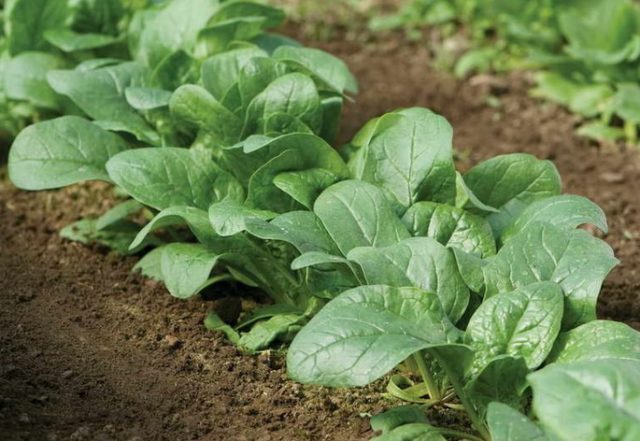

Spinach Giant
The Giant spinach variety was included in the State Register in 1978. The plant has a compact rosette with a diameter of about 50 cm. The length of the leaf plate is up to 18 cm, the width is up to 14 cm, the color is light green, the surface is wrinkled. With good care in the open field, the mass of one plant is 20-28 g. Giant spinach has an early ripening period. The crop can be harvested after 2 weeks of cultivation from the moment of germination, from 1 sq. m - up to 2.5 kg.
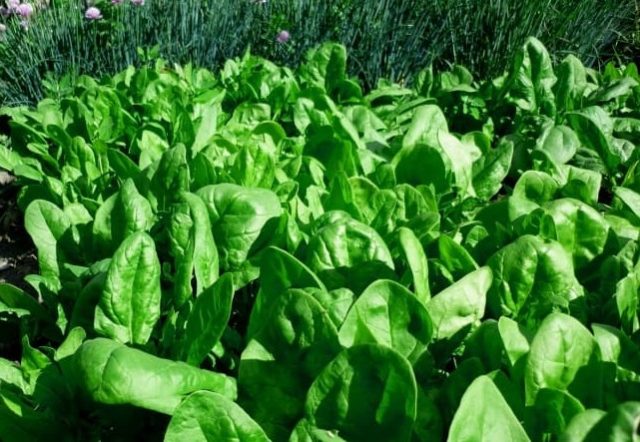

Red spinach
The color of spinach is not only green, but also red. The veins and leaf petioles are the most intensely colored. Red spinach varieties.
Bordeaux F1 - green leaves with red petioles and veins. The diameter of the rosette is about 30 cm, the height is up to 20 cm. It grows well when planted outdoors in a sunny place, the taste is sweeter than that of green spinach.
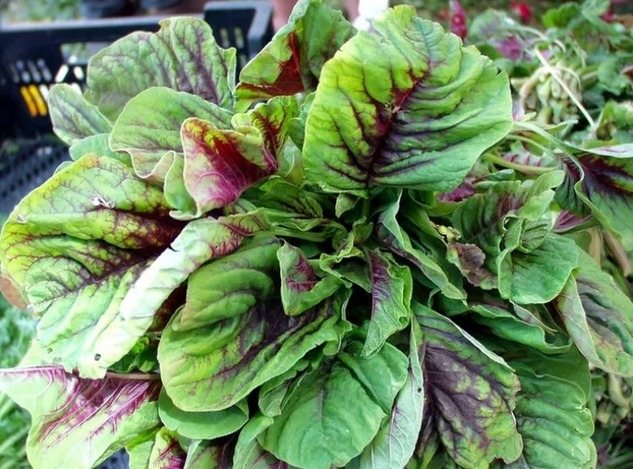

Red Cardinal F1 is a hybrid with green leaves, pink veins and petioles. Undemanding to care for, resistant to powdery mildew. Ripening in open ground is 30-40 days after germination.
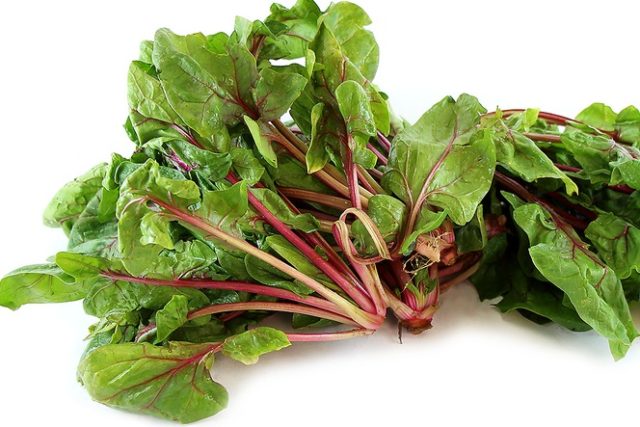

Red spinach is sometimes referred to as a related plant that is grown outdoors, like leafy greens such as Swiss chard.


Spinach Uteusha
This is an interesting hybrid of spinach and sorrel, discovered in the second half of the 20th century by the Ukrainian scientist Yu. A. Uteush. The plant does not require special care, it is grown for salads and soups, as well as a forage crop. The height of the bushes in summer reaches 2 m. Growing seedlings in a greenhouse gives good results. Then the formed bushes are transplanted into open ground, in one place they can grow up to 15 years. The plant tastes like a mixture of spinach and sorrel.
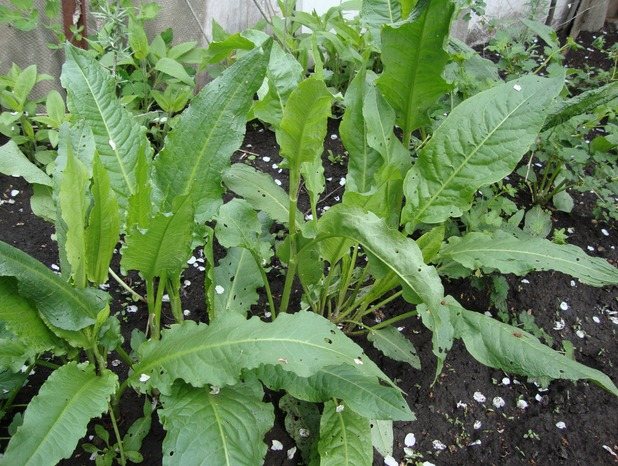

Spinach victoria
The late-ripening spinach variety Victoria was included in the State Register in 1950. The growing period from germination of seeds to ripening of the crop is 19-37 days. Semicircular dark green leaves of the plant are collected in a compact rosette with a diameter of up to 20 cm. The amount of harvest per 1 sq. m in the open field is 2.5-3.5 kg, the weight of one plant is up to 28 g. Spinach is suitable for fresh consumption and heat treatment - making salads, soups, sauces.
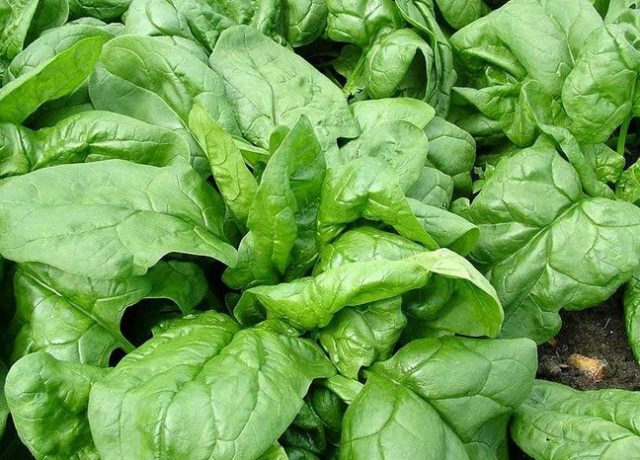

Spinach Popeye
Spinach Papay belongs to the varieties of domestic selection, it was entered in the State Register in 2020. The leaf rosette is semi-horizontal, up to 25 cm high, the weight of one plant is up to 35 g, the yield is from 1 sq. m when grown outdoors - up to 3 kg. Leaves are dark green with excellent flavor, medium arrowing. The variety is early maturing, the crop is recommended for cultivation in all regions of Russia.
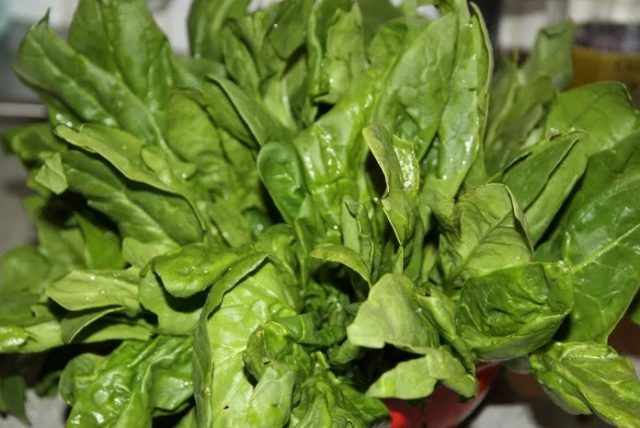

Spinach boa
The Boa hybrid variety is included in the State Register in 2020. It was bred in the Netherlands and belongs to the early maturing hybrids of the first generation. Resistant to cold and disease, suitable for growing outdoors in all regions of Russia. Leaves are oval green, growing on petioles of medium length. Leaf rosette horizontal or semi-upright, up to 15 cm in diameter, weight - up to 60 g. Productivity from 1 sq. M. m in open ground - up to 1.7 kg. The advantage of growing a Boa crop is the late shooting.
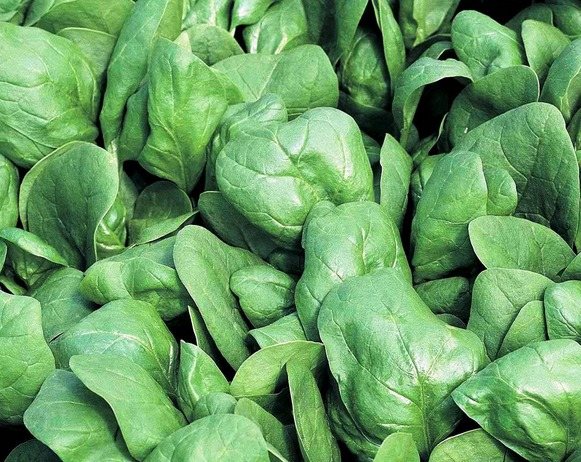

When to harvest and how to store
Spinach is a rosette of glossy leaves. This is a heterosexual plant. There are male and female representatives of the vegetable. In male specimens, small and few leaves emerge from the sinuses. They are removed during thinning. Large, juicy leaves for cutting are given by females, they are left in the beds.
Spinach has excellent gardening benefits, including:
- The plant is not afraid of cold weather. Seeds begin to germinate at a temperature of 4 degrees, the emerged seedlings are able to withstand short-term spring frosts.
- Early maturity and high yield. The growing season of the plant lasts 1 month.You can plant it in your summer cottage several times every 2 weeks during the season. But the best time to harvest is spring. Leaves are more juicy and fleshy in spring.
Before you start growing spinach from seed, you need to choose the right plant variety. When choosing a variety, pay attention to the ripening time of the crop, which is indicated on the seed bag label. Having picked up seeds of different types, you can organize a conveyor collection on your site. All varieties and hybrids are divided into early, medium ripening and late.
- Early varieties. After 15 days after germination, you can already cut the leaves. If sowed late, the crop will start shooting early. The early maturing ones include Matador, Gigantic, Round dance. Please note that each of them has additional qualities: Matador is resistant to low temperatures and bloom. By the way, this is one of the highest-yielding and popular varieties. You can learn more about it on the Internet, as well as order seeds. You will need to enter into the search "Matador spinach growing from seeds"
- Giant can be grown both outdoors and protected. Does not throw out arrows for a long time, is resistant to nitrate accumulation.
- The round dance has a high vitamin content.
It should be added that the constant selection work on the development of new varieties of spinach, low-shooting early, resistant to powdery mildew, giving a large mass of greenery, does not stop. Every year new items appear. Undoubtedly, the early ripening variety of strawberry spinach and its cultivation from seeds will arouse the interest of summer residents.
It gives, in addition to juicy leaves, fruits that have a strawberry aroma. The fruits are suitable for food and for processing. Strawberry spinach is an annual plant up to 50 cm high. Fruit ovaries appear in the axils of the plant. On the fourth day after the formation of the ovaries, the fruits ripen and are ready to eat. Moreover, growing strawberry spinach is not particularly difficult.
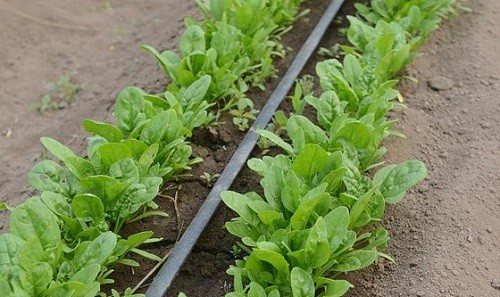

You can sow spinach seeds both outdoors and on seedlings in greenhouses. The method of growing through seedlings is not very popular. The roots of the seedlings of green culture are weak, when transplanted to the garden they are injured, they do not take root well. It is best applied to thermophilic spinach varieties (Matador, New Zealand).
You can sow spinach in open ground in August, early spring, in April, before winter. At a temperature of 5 degrees, planting can begin. When sowing, follow the instructions:
- Make tape-type grooves in 2-5 stitches. The distance between the lines is 20 cm, the row spacing is 40-50 cm. The depth of planting seeds on loamy soils is 2-2.5 cm, sandy loam - up to 4 cm. Between the seeds in a row 5-8 cm. Expect to sow 3 g per 1 square meter of the site seeds.
- Squeeze the crops lightly, pour water on.
- It is advisable to cover the bed with a film to protect against possible night frosts and to accelerate the emergence of shoots.
- A week and a half after sowing, shoots will appear.
Seedling care consists of watering, mulching, weeding, loosening, thinning, and pest protection.
- Plants love watering. Only with good watering will you get fleshy, large leaves. In the absence of rain, it is necessary to water using a bucket of water per square meter. In dry, hot weather, it is recommended to water up to 3 times a week.
- Growing and caring for spinach in the open field or in a greenhouse does not allow waterlogging: the culture can be affected by root rot.
- Mulching is done with grass, straw to retain moisture in the soil.
- Weeding is carried out for the first time after the growth of the first true leaf. The beds should be freed from weeds regularly, not only in order to improve the vital activity of the plant, but also to protect against caterpillars and aphids.
- Loosening is performed fine, to remove the crust and access oxygen to the roots.
- Thinning is carried out simultaneously with the first weeding - in the phase of the appearance of the first leaf. A distance of 10 cm is left between individual shoots. With a denser planting, there is a risk of root rot or powdery mildew.
- Disease control. The most common disease of greenery is root rot. If found, the diseased plant should be pulled out by the root, and the planting should be treated with 1% Bordeaux mixture. From pests, crops are treated with tobacco dust infusion or ready-made biological products.
It is recommended to harvest the spinach in the morning, before preparing meals. Large leaves are harvested from young plants that do not have peduncles. Pay attention to the specifics of the collection:
- The leaves are broken off one at a time.
- The rosettes are cut under the first leaf so that less dirt gets on the greens, and so that the further planted plant can continue to grow.
- Cutting is carried out when the leaves reach a length of 18 cm.
- The number of leaves on a ripe and ready-to-cut plant should be at least 6.
- Harvesting in the garden should be done regularly as spinach overripe quickly.
- When the arrows of the peduncles begin to appear, the plant is removed from the garden.
- The seeds of the plant ripen in 3 months. In the ripening phase, it is necessary to cut off the brown inflorescences, put in a shaded place for ripening.
- Seed germination, which is properly stored in a dry and cool place, lasts 4 years.
For your information, seeds are harvested only if one variety grows on the site, since spinach is a wind-pollinated crop. It is enough to leave 2 female plants in the beds with a distance of 20 cm between them to get a good yield of seeds. Such a low-calorie, vitamin-rich product such as spinach is ideal for dietary nutrition. Eating spinach improves immunity, relieves fatigue, it is recommended for diabetes, childhood rickets (high vitamin D content).
With proper care, you can get fresh tender leaves within 2-3 weeks after planting.
Growing and caring for spinach in the open field should include watering, loosening, and weeding.
It is also important to shelter the plants from the scorching rays and, if necessary, feed them.
A herbaceous plant grown on the site needs constant watering.
As for the frequency, the bushes are watered 2-3 times in 7 days.
This is, of course, approximate, because weather conditions can vary.
In order not to flood the plant, it is important to reduce watering during rainy summer.
Excessive water content in the soil can lead to the appearance of various diseases.
It is recommended to use the sprinkling method so as not to damage the green bushes.
For 1 sq. m. approximately consume up to 10 liters of water. It is recommended to use non-cold water.
Top dressing
It is not difficult to understand how to grow spinach in the country. An unpretentious herbaceous plant yields a crop even without the use of dressings.
In some cases, for example, when the weather conditions are too unfavorable, you need to help spinach. Sometimes its rosettes develop slowly and poorly.
This means that the plant lacks nitrogen. The situation can be corrected by feeding with nitrogen-containing additives.
Nitrogen fertilizer granules are embedded in the soil. Planting depth - 2-5 cm. After fertilization, the rows must be watered.
Weeding and loosening
Like all plants, spinach needs grooming. Loosening the soil helps oxygen to penetrate to the roots. From this, it begins to develop rapidly.
Weeds inhibit the growth of spinach, especially in the early stages of its development. That is why you need to get rid of them in a timely manner.
This will help preserve nutrients and trace elements in the soil, which will go to spinach.
Shelter in the heat
All varieties of greenery need shelter. It is required in hot weather, when the hot, scorching sun appears.
To prevent the plant from getting burned, it must be covered with a special material. Nonwovens are available at the store.


If shading is not applied, the leaves become rough and lose their taste.
As a rule, you can collect greens if the plant has 8-10 leaves.
But sometimes gardeners cut it even with 6 sheets available.
You need to cut them off under the first sheet.
You can also dig up or pull out the whole plant. The main thing is not to delay the harvest.
Leaves harvested late are tougher, less juicy and less tasty.
Also note that picking herbs is best in the morning. It is not recommended to cut the leaves after rain.
The collected greens can be stored in the refrigerator for 2 days.
If spinach is needed for consumption after a few days or weeks, it can be dried or frozen. Frozen greens retain all the nutrients.
Planting spinach can be carried out in the aisles. For this, the best neighbors for him will be:
- potatoes;
- beans;
- eggplant;
- corn;
- cabbage.
Garden strawberries, onions or celery also grow well with spinach.
Healthy greens can also be grown in separate beds.
Spinach is an excellent plant that requires little effort to grow.
When to sow spinach outdoors
Sowing spinach in the open field is carried out from late April to mid-August with an interval of 3-4 weeks. Seeds germinate at + 4 ° C. Open shoots can withstand frosts down to -5 ° C, and mature plants even up to -15 ° C. Thanks to this frost resistance, spinach can be grown on the site throughout the growing season.
Important! Greens harvested in spring and autumn will be the juiciest. The optimum temperature for growing is + 15 ... + 20 ° C, at a higher temperature the plant quickly goes into the arrow.
Vegetables that are good precursors for outdoor cultivation include:
- potatoes;
- cabbage;
- radish.
To get an early harvest, you can build a nonwoven shelter over the garden bed. In warm weather, seedlings appear in 4-5 days.
When to plant early, mid-season and late varieties?
Spinach in the middle lane and northern regions is planted based on weather conditions and the purpose of growing. Early ripening varieties are planted on a conveyor belt in order to harvest several times per season. Varieties with a longer ripening period are planted according to the weather, although spinach is frost-resistant, but too low a temperature will lead to a weakening of the root system and the death of the plant.
In Central Russia
In Central Russia, weather conditions at the end of April make it possible to plant this crop. Early ripening varieties are sown from late April to late August, and mid-ripening varieties are sown from mid-April to late July.
In Siberia
In Siberia, disembarkation begins no earlier than the May holidays.... Only in mid-May does the ground get warm enough for the seeds to sprout successfully.
In the Urals
The landing time in this region is about the same as in Siberia. Many people plant a crop in the summer, in June or July, then the harvest occurs in early autumn. But, since in especially sunny weather the plant is prone to shooting and flowering, you should choose species that are not susceptible to this phenomenon or hybrids.
Since spinach is an undemanding and resilient plant, it can be grown just as well in harsh climates as in central regions. The first spring planting takes place about a month later, and early fall falls are taken into account. There are no fundamental differences in care and cultivation.
How to plant spinach
When grown outdoors, spinach does not require much maintenance. The seeds are buried in the soil by 2-3 cm. They are planted in furrows or holes located at a distance of 20 cm from each other. Place 2-3 seeds in each well. When shoots appear, they are left to grow one by one, the strongest, the rest are pulled out.
When planting in furrows, sowing is done at a distance of 2-3 cm, the seeds are large, so it is easy to maintain the required gap between them. The distance between furrows in the open field is left 20-25 cm. If during daily maintenance the moisture of the beds is maintained, seedlings will appear about a week after sowing.
Seedlings are thinned out in the phase of two true leaves. A distance of 8-10 cm is left between the plants in the open field. Planting of late varieties with a large diameter of leaf rosettes during cultivation is thinned out as it grows, using young greens for food.
Landing site preparation
The plant is undemanding to the soil, it grows on any other than acidic and heavy. To get a good harvest, the site is prepared in the fall. The garden bed is dug up, a bucket of humus and a glass of wood ash are brought in for each square meter. Deoxidized peat and river sand are also added to make the land looser and more fertile, suitable for growing crops.
In the spring, before planting spinach seeds in open ground, the plot is leveled, compacted and well watered. For sowing, furrows are made with a depth of 2 cm, maintaining a distance between them of 20-25 cm.
Seed preparation
Spinach seeds for spring sowing in open ground are prepared in advance. They are covered with a dense shell, so you have to wait a long time for the first shoots. This structural feature allows the seeds to successfully winter in the open field, germinating during the first spring thaw.
To speed up the emergence of seedlings in spring, before sowing, the seeds are soaked for 2-3 days in water (+30 ° C) or mixed with moist rotted sawdust and placed in a warm place for several days.
How to plant spinach outdoors
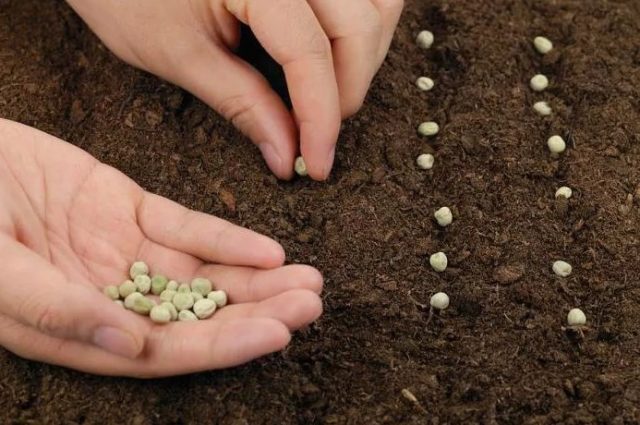

Spinach is sown in open ground before winter or early spring. This cold-resistant crop, undemanding to care, begins to grow before all other vegetables. Seeds are laid out in the prepared furrows, keeping a small distance between them. Sprinkle with soil on top, level and mulch. Watering from a watering can in the aisles so as not to wash out crops.
To get an earlier harvest in the open field, cover the bed with foil. When shoots appear, they remove the shelter during the day and return it again at night, protecting it from frost. Seedlings can be grown on a windowsill, they do not require special care.
Choosing a landing site
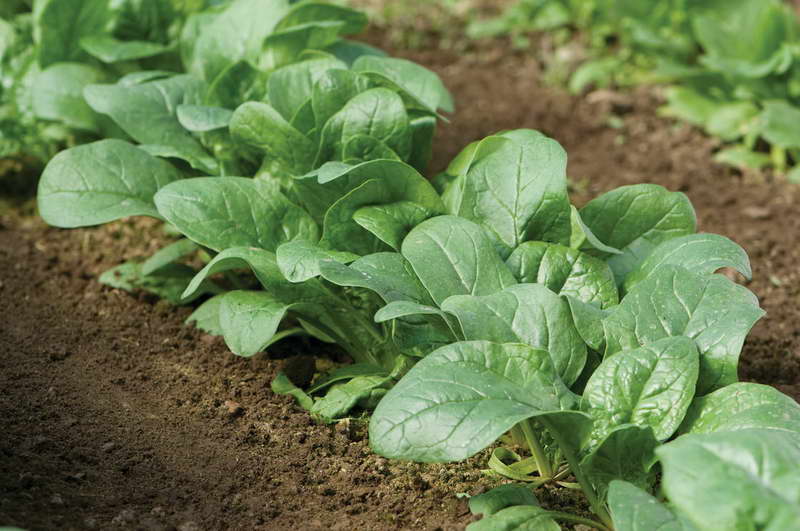

The best place to plant spinach is in well-lit areas, which eliminate the likelihood of stagnant water. For early greens, the spinach bed should be placed on a southern slope, protected from the cold wind.
If the garden is in a low-lying area, spinach can be planted in a garden bed with planks. Since the root system of spinach is not very long, the bed may not be very tall.
Spinach, planted in early spring, can be used as a precursor to thermophilic vegetables at a later ripening period. In small garden plots, it can be planted as a sealant (most often between rows of other vegetables).
How to grow spinach in the garden
Dates for planting spinach outdoors fall in the spring and late summer: from April to May and from July to August. A place for growing crops is chosen well-lit with fertile or fertilized loose soils. Caring for spinach in the open field is simple - thinning crops, weeding, loosening the soil, watering.
Comment! You can sow seeds in the aisles of a garden or vegetable garden occupied by other plants. When growing, the roots of the plant secrete active substances into the open ground - saponins, which have a beneficial effect on other vegetable and garden crops.
Watering and feeding
When growing spinach outdoors, keep in mind that it loves water. In hot dry weather, it has to be watered almost every day. This leafy vegetable is capable of accumulating nitrates, therefore, it is better to refuse nitrogen and organic fertilizers for self-care and growing in the garden. Organic and mineral fertilizing is applied in open ground at the pre-sowing stage.
The care for industrial cultivation is different. Seedlings are fed with potash and nitrogen fertilizers at 0.1 t / ha, adding them simultaneously with watering.
Weeding and loosening
After each watering, the aisles are loosened - such care helps the development of roots and the growth of leaf mass. To reduce the amount of watering and loosening, mulch the beds with humus or compost. When grown on heavy soil, which retains moisture and does not allow air to pass through, spinach grows poorly, therefore, before planting, deoxidized peat, rotted compost and river sand are introduced.
Protection against diseases and pests
Strong spinach bushes are rarely affected by diseases and pests in the open field - this makes maintenance easier. Good plant immunity is important because insecticide and fungicide treatments are prohibited when growing leafy early ripening greens. In unfavorable weather conditions, crop losses are possible. High humidity during frequent rains leads to a downy mildew attack. For the prevention of fungal infections, it is advisable to treat the beds before sowing with "Fitosporin" or "Trichodermin".
On dry days, leaf aphids, a carrier of the beet jaundice virus, parasitize spinach bushes. It is important to maintain optimum soil moisture during cultivation. For pest control, it is better to use folk methods - infusions of onion husks, tobacco, makhorka, soap solutions, etc.
Improper care - waterlogging or drying out of open ground, its increased acidity can lead to yellowing of leaves and a stop in growth. A mistake is a thickened planting, placing beets near the beds, which have common pests with spinach - beet nematodes and leaf aphids.
Diseases and pests
Most often, this culture suffers from fusarium rot, curl or mosaic. Most spinach diseases are caused by fungi. If the plant has caught the "infection", then all its parts are affected - stems, leaves, rhizomes. The following lesions are external signs:
- decay of leaves, rhizomes;
- twisting foliage, as well as its cracking, the appearance of holes;
- pigment spots on the tops are lighter or darker than the main natural tone.
It is not worth eating such a plant; it must be taken out and disposed of. The bed itself will need to be treated with special agents against diseases. The same is the case with pests - if you find the presence of pests, spray the plants with insecticide, and wait two weeks before adding the plant to food.
You should not take the most powerful poisons, hoping that they will quickly and effectively kill insects, because the plant absorbs moisture, and with it the poison itself - you risk your health.
You can use insecticides such as Parus, Aktofit, Aktara, or, in extreme cases, you can apply Regent, Karate. But the last two are too poisonous and are used only in case of total defeat, it is impossible to eat the leaves of the plant with this treatment for 20-30 days.
How to grow spinach in a greenhouse
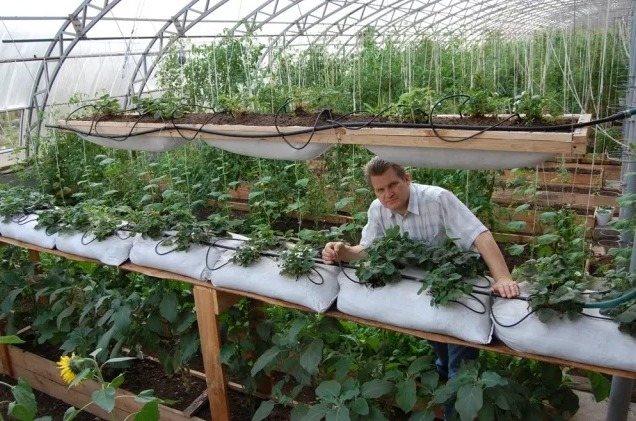

Spinach is easy to grow in a greenhouse for the winter. The seeds are sown from September to February. To accelerate germination, they are pre-soaked for 1-2 days.To reduce the cost of caring for the crop, the temperature is maintained at + 10 ... + 15 ° C. Young spinach easily tolerates small frosts. Greenhouse care includes weeding, watering, airing on warm days.
In February or March, when it is too early to plant spinach outdoors, start sowing seeds in containers. Technology for growing and caring for seedlings in a greenhouse:
- For sowing in a small home greenhouse, they take plastic containers with drainage holes at the bottom.
- The soil for growing needs loose and nutritious; universal soil from the store is suitable. It is poured into a planting container, moistened from a spray bottle.
- Seeds are laid out on the soil surface in furrows, this facilitates further cultivation and maintenance. You can simply sow, and when seedlings appear, dive them into separate containers.
- Sprinkle the seeds on top with a layer of soil about 2 cm.
- Cover the container with a transparent lid or bag, put it in a warm, bright place in a greenhouse. The optimum temperature for germination is + 18… + 20 ° C.
- In 5-7 days from the moment of sowing the soaked seeds, friendly shoots appear.
- Seedling containers are left open, moistened as the soil dries out.
- Further care consists in watering with settled water using a spray bottle.
After about 2 weeks, you can eat greens of early ripening varieties or plant grown seedlings in greenhouse beds.
Spinach crop care
Spinach is quite unpretentious to weather conditions. He loves the sun, but it can grow in the shade, it survives frost well. Spinach serves as a compactor, it is sown in empty areas between other crops. Requires moderate watering.
When to plant gladioli in 2020 and how to properly care for flowers
Expert opinion
Lydia Ponomarenko
Experienced gardener, gardener and florist.
Do not pour too much water on the spinach every day, this can lead to plant disease and the appearance of molds.
Sown areas are thinned out with the appearance of several green leaves with a distance of about 20 centimeters. As the land dries up, they are loosened.
If the summer turned out to be dry, then you need to water more often and monitor the air exchange.
When the summer is rainy, it is worth taking care of covering the spinach bushes with covering material. This will serve as a plastic wrap. It will protect the plant from excessive soil moisture and leaf rot.
Growing spinach industrially
You can industrially grow spinach in a greenhouse or open field. High-yielding, shoot-resistant and easy-to-care varieties with an early ripening period, such as Boa, are selected.
Advice! To obtain high-quality products, sowing in the open field is carried out in two stages - from February to May and from the end of July to the second decade of August.
The soil is fertile, loose, with neutral acidity. Preliminary preparation of the site includes liming the soil, adding compost or humus at 30 t / ha, superphosphate and potassium chloride at 1.5 c / ha. In the spring, the field is harrowed, before sowing, it is cultivated, fertilizing with ammonium nitrate at a rate of 2 c / ha.
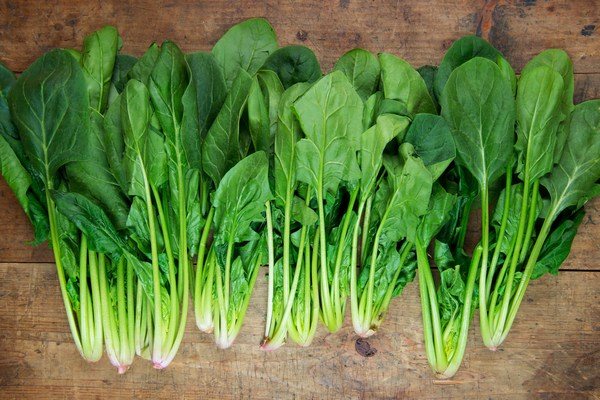

For industrial cultivation and caring for spinach in the open field, planting using a multi-line belt method according to the scheme 32x75 cm is used. The rate of seed consumption per 1 hectare is from 25 to 40 kg. When the seedlings form 2 true leaves, thinning is carried out, leaving a distance of at least 8 cm between them. Further care in the open field includes weeding and watering. Net harrowing helps in weed control.
Harvesting begins when the plants form rosettes of 6-8 well-developed leaves. Spinach is plucked by the root or cut at the level of the lower leaves. The maximum amount of harvest from 1 hectare in the open field is 300 centners. On large fields, a machine with a KIR-1.5 transport trolley is used for harvesting.
How to proceed in the summer?
If spinach is planted in the summer months, depending on the ripening period, the ready-to-eat leaves are harvested in the fall, before the onset of frost.
Summer
In summer, mid-ripening and early-ripening, flowering-resistant species are planted.
Matador
For summer planting, seeds are sown in mid-June.... Known as a fruitful variety, the rosette reaches a size of 30-50 cm.
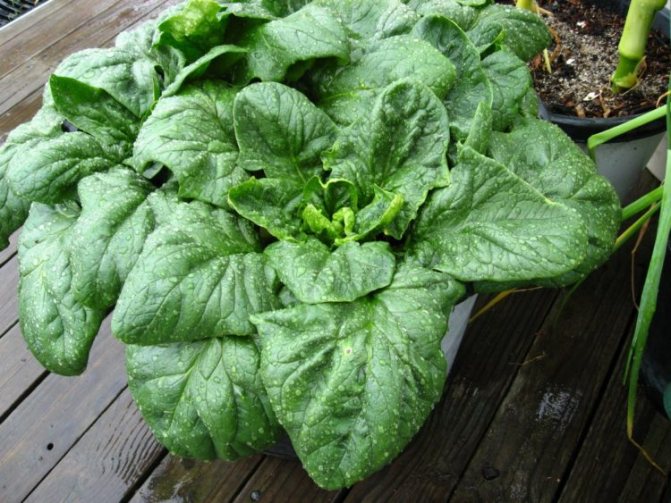

Fatty
A mid-season variety that also tolerates the hot summer months without a pronounced flowering. Planted from late May to late August. Medium rosette 17-28 cm.
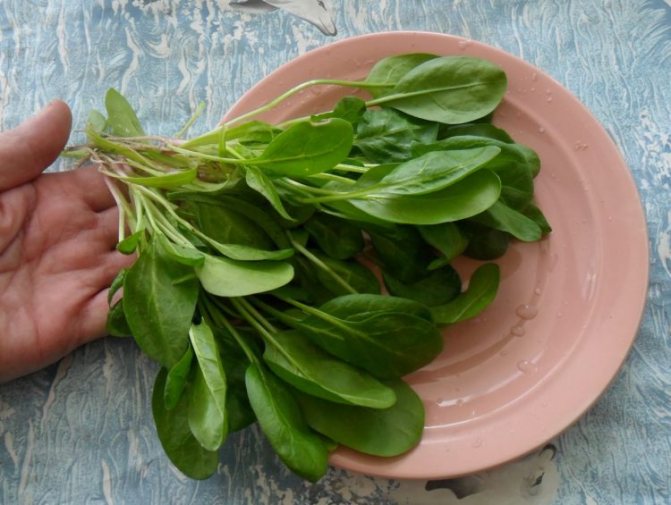

Victoria
Late-ripening type of plant. It has a shallow rosette and is resistant to flowering, so the harvesting period reaches 30 days. Planted until November, but for the summer harvest, seeds are sown in May..
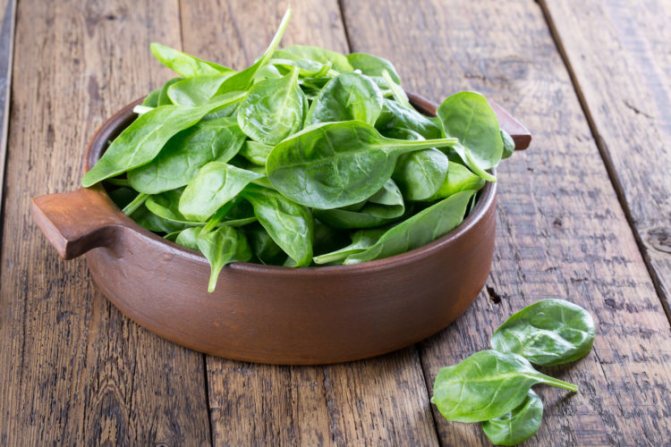

New Zealand
Has high yield rates. Loves warmth, light, moisture, therefore it is suitable for growing in summer. The green mass is ready to be harvested 25-35 days after germination. It is grown outdoors from May until the first frost.
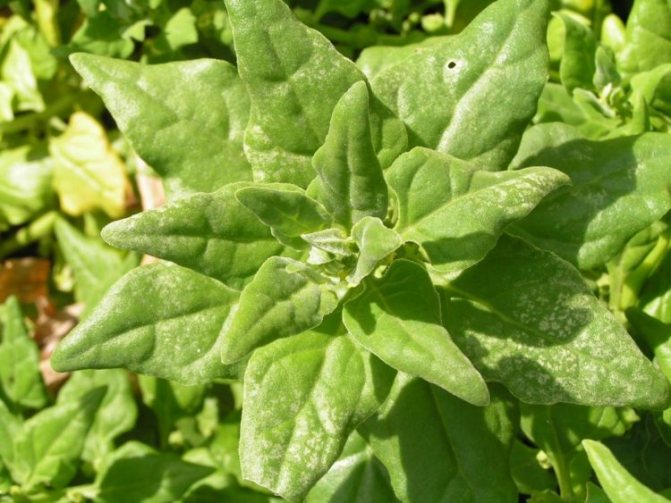

Soil development
When planting plants in summer, fertilizer is applied to the soil two weeks before sowing. Provides constant watering for high yields, before planting, the ground is also moistened. The addition of ammonium sulfate stimulates rapid growth. The seeds are supposed to be soaked for two days, as well as during spring sowing.
How to proceed?
When planting in summer, it is necessary to remember about additional moisture, in contrast to spring, when the soil is saturated with melt water, and shading of the crop if the temperature rises above 26⁰С.
After sowing, it is recommended to cover the bed with a film; in a greenhouse, the seeds will germinate more easily and faster.
Harvesting
Harvesting in the open field is undesirable after rain or watering, so that the base of the leaf outlet does not rot in the place where the leaves are torn off. Plants harvested early in the morning retain their presentation and freshness better.
Spinach belongs to early maturing crops, very easy to care for. Planting of some varieties ripens 14-20 days after germination. It is not worth delaying the harvest, the overgrown leaves will become rough, with age they lose their nutritional value. The crop is used fresh, boiled, stewed, frozen and canned. Fresh leaves are stored for no more than 5-7 days, and at a temperature of 0 ° C and a humidity of 100% - up to 14 days.
Comment! Spinach is best eaten fresh on the day of harvest.
You can sow seeds outdoors in the second half of summer to reap a second crop in the fall. The space vacated in early June in the garden can be taken with tomato seedlings.
Preparing seeds for sowing, whether it is necessary to soak them
Spinach seeds, like some other green crops, are distinguished by the fact that they are covered with a hard shell, it does not allow moisture to pass through well. Therefore, seeds sown dry germinate for a very long time and unevenly, they must be prepared for sowing. At the same time, they are quite large and available for manual calibration: it is quite possible to see the smallest seeds and specimens with defects with the naked eye. It is advisable to immediately select and delete them. If there is a sufficient number of seeds, it is worth selecting only the largest ones for planting.
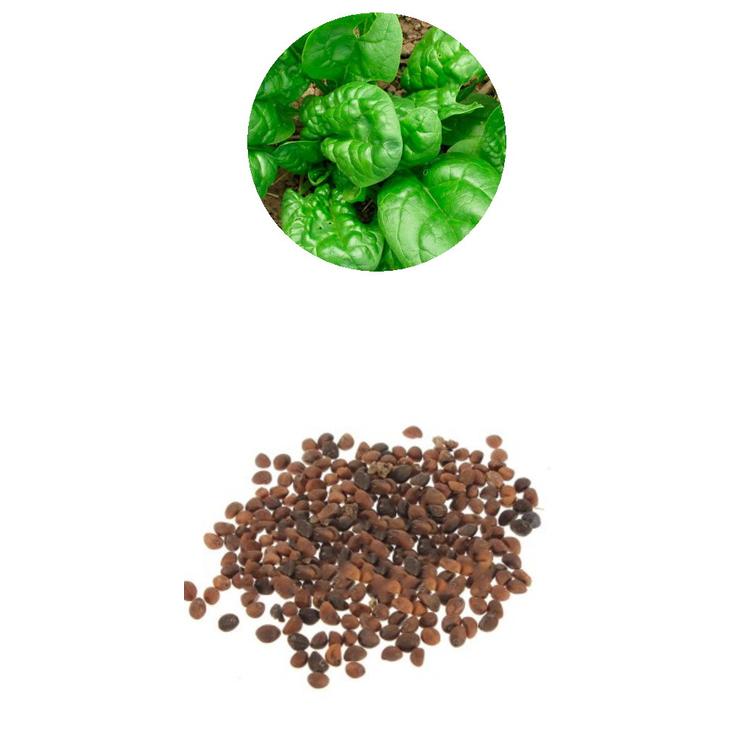

Spinach seeds are easy to handle due to their large size
The soaking operation is very simple and should not be neglected. This is usually done by placing the seeds in a cotton cloth and placing the cloth on any plate. Water at room temperature is poured in a little: so that the fabric is reliably moistened. They keep the seeds in this state for about a day in a warm place, while changing the water from time to time, making sure that the tissue does not dry out.
After soaking, it is advisable to disinfect the seeds. To do this, they are placed in a dark solution of potassium permanganate (with a concentration of about 0.5%) and kept in it for 10-12 minutes.Then the solution is drained, the seeds are washed thoroughly in ordinary water and slightly dried until they are free-flowing, allowing free sowing.
Reproduction
Spinach is an annual herb from the Amaranth family. Unpretentious in care, propagated by seeds. A hybrid with sorrel Uteusha is a perennial, can be propagated by dividing the bush.
The seeds are bought in the store or collected their own. For this, the strongest and largest plants are left in the open field during care. Seeds ripen by August. Plants with seed pods are pulled out, allowed to dry in an open attic, and then the required amount is husked and stored in a dry, dark place until sowing. The seed yield is 45 g / sq. m, they remain viable for 3-4 years.
Soil preparation
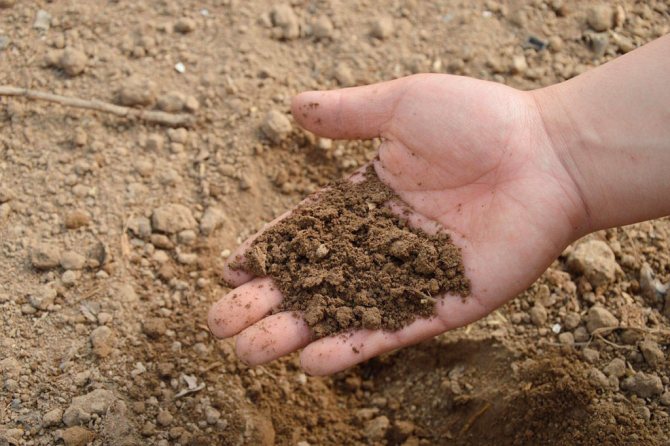

Spinach is one of the plants with high requirements for soil fertility, therefore its ideal predecessors are vegetable crops, under which organic fertilizers have been applied in sufficient quantities.
Spinach will grow well in cultivated areas with fertile, rich in organic matter, soils that have normal acidity and good water retention capacity. All these conditions are met by light loamy soils.
Before growing spinach, it is necessary to prepare the site in the fall:
- The soil is carefully dug to the depth of the shovel bayonet and potassium-phosphorus fertilizers are applied to it. For example, a mixture consisting of potassium chloride (15 g) and superphosphate (30 g) can be applied for each square meter of the site.
- At the same time, liming of soils characterized by high acidity is carried out.
- If desired, you can enrich the soil with a half dose of nitrogen fertilizers; the remaining dose is applied to the ground in early spring.
- Organic matter can be an excellent substitute for purchased fertilizers: rotted manure or compost. They are brought in at the rate of 6-7 kg per 1 m2.
In early spring, immediately after the soil thaws, urea is scattered over its surface (20 g per square meter), and then harrowed with a rake. Too poor soil just before sowing spinach can be enriched with a compound fertilizer. For each square meter you will need: 10 g of potassium, 6 g of phosphorus and 7 g of nitrogen.

